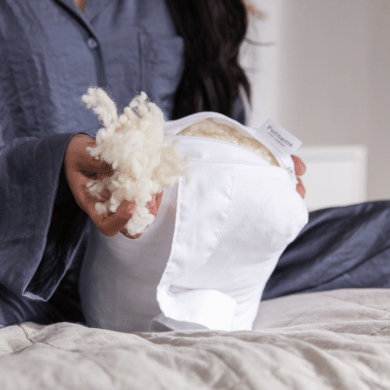
Soulager la congestion et les problèmes de sinus grâce à la literie
Imaginez-vous vous réveiller chaque matin en vous sentant reposé et revigoré, avec la tête claire et une respiration facile. Pour beaucoup, ce début de journée paisible n'est qu'un rêve, obscurci par le brouillard de la congestion des sinus et l'inconfort incessant des allergies.
Mais que se passerait-il si le secret d'une nuit de sommeil plus réparatrice et d'une journée plus claire se trouvait dans votre chambre, caché à la vue de tous dans votre literie ?
Voici votre guide pour transformer votre sanctuaire du sommeil en une oasis de santé, offrant des informations sur le choix de la bonne literie pour lutter contre la congestion, les allergies et les problèmes de sinus.
Comprendre les allergies et la congestion des sinus
Les allergies et la congestion des sinus peuvent avoir de graves répercussions sur votre qualité de vie.
Les allergènes courants présents dans la literie comprennent les acariens, les squames d'animaux et le pollen. Ces minuscules particules peuvent déclencher des réactions allergiques, entraînant des symptômes tels que la congestion nasale, les éternuements et les démangeaisons oculaires.
Une étude de 2021 du European Respiratory Journal a révélé que les housses de literie imperméables aux allergènes peuvent réduire considérablement la gravité des symptômes d'asthme et d'allergie chez les adultes et les enfants.
Les acariens se développent dans des environnements chauds et humides, ce qui fait de votre lit un terrain fertile. Selon l' Institut national des sciences de la santé environnementale, plus de 20 millions d'Américains sont allergiques aux acariens, la literie étant un réservoir majeur de ces nuisibles.
Les squames d’animaux et le pollen peuvent également se déposer sur votre literie, aggravant les problèmes de sinus et rendant la respiration difficile, surtout la nuit.
Après tout, qui peut dire « non » à ses adorables petits chiens ?
Est-ce simplement un nez bouché ?
Et bien oui et non.
Ce n'est là qu'un des symptômes qui peuvent avoir des conséquences graves et perturbantes sur le bien-être des personnes. Cette affection est souvent appelée rhinosinusite ou simplement sinusite dans les milieux médicaux et il en existe plusieurs variantes.
Rhinosinusite Il s’agit d’une inflammation des sinus et des voies nasales, provoquant souvent une congestion.
-
Types de rhinosinusite :
- Infectieux : Causé par des virus comme le rhume.
- Allergique saisonnière : due au pollen au printemps et à l’automne.
- Allergique : Déclenché par des allergènes ou des irritants.
- Allergique pérenne : Provenant d’allergènes présents toute l’année comme les acariens et les squames d’animaux.
- Non allergène : Causé par des irritants comme la fumée et la pollution.
-
Autres causes de congestion :
- Positionnement du corps : La position allongée peut aggraver la congestion.
- Problèmes structurels : problèmes tels qu’une déviation de la cloison nasale ou des polypes nasaux.
- Problèmes de santé : Maladies affectant le mouvement du mucus, comme la fibrose kystique.
Les personnes dont le système immunitaire est affaibli sont plus sensibles à la congestion due aux infections.
Le journal The Independent a nommé l'oreiller anti-ronflement Putnam's comme le meilleur pour le drainage des sinus (septembre 2024)
Comprendre la congestion nocturne
De nombreuses personnes constatent que leur congestion s'aggrave la nuit, ce qui les empêche de bien dormir. Cela peut être dû à diverses raisons, notamment les allergies, l'écoulement nasal postérieur et les infections des sinus.
En position allongée, le mucus s'accumule dans les voies nasales, ce qui peut aggraver les symptômes. Pour lutter contre ce phénomène, les personnes ont souvent recours à divers produits de nuit tels que des vaporisateurs nasaux, des humidificateurs et des antihistaminiques.
Le rôle de la literie dans le soulagement des problèmes de sinus
Votre literie peut faire une différence significative dans votre lutte contre la congestion nocturne. Les acariens, les squames d'animaux et le pollen peuvent s'accumuler dans vos draps et oreillers, déclenchant des réactions allergiques et aggravant les problèmes de sinus.
Passer à une literie hypoallergénique et antiallergique peut réduire considérablement ces irritants.
Principaux avantages de la literie hypoallergénique
Découvrez le pouvoir transformateur de la literie et des oreillers hypoallergéniques, spécialement conçus pour offrir un soulagement aux personnes souffrant de congestion et de problèmes de sinus, assurant une expérience de sommeil réparatrice et rajeunissante.
-
Défense contre les allergènes : dites adieu aux nuits blanches causées par les acariens et les allergènes. La literie et les oreillers hypoallergéniques sont fabriqués à partir de matériaux de pointe qui résistent efficacement à ces irritants, créant ainsi un environnement de sommeil plus propre. Cette défense réduit considérablement les déclencheurs de congestion des sinus, ce qui entraîne moins d'interruptions pendant la nuit et vous permet de vous réveiller en vous sentant plus reposé et sans symptômes.
-
Confort respirant : Profitez de l'étreinte apaisante des matériaux respirants qui améliorent la circulation de l'air tout au long de la nuit. Les options hypoallergéniques comportent souvent des tissus comme le bambou et le coton hypoallergénique, qui offrent une ventilation supérieure. Cette respirabilité aide à maintenir des niveaux d'humidité optimaux et empêche l'accumulation d'humidité, ce qui peut aggraver les problèmes de sinus, favorisant ainsi un sommeil plus confortable et ininterrompu.
-
Propriétés d'évacuation de l'humidité : évitez l'inconfort grâce à une literie évacuant l'humidité qui aide à réguler la température corporelle et minimise l'humidité. En évacuant l'humidité de votre corps, ces produits réduisent le risque de vous réveiller avec le nez bouché ou des symptômes de sinus aggravés. Cette caractéristique favorise non seulement un environnement de sommeil plus sain, mais contribue également au bien-être général en vous assurant de rester au sec, confortable et à l'aise tout au long de la nuit.
Optez pour une literie et des oreillers hypoallergéniques pour créer un sanctuaire qui non seulement soulage la congestion et les problèmes de sinus, mais améliore également la qualité de votre sommeil et votre santé globale.
Choisir la bonne literie pour soulager les sinus
Oreillers pour la congestion des sinus
Choisir le bon oreiller est essentiel pour soulager la congestion des sinus.
Recherchez des oreillers spécialement conçus pour les personnes souffrant de sinus, tels que des oreillers compensés ou des oreillers à hauteur réglable.
Coussins compensés pour les personnes souffrant de sinus
Les oreillers compensés surélèvent votre tête et le haut de votre corps, aidant ainsi à garder vos voies respiratoires ouvertes et à réduire l’écoulement post-nasal.
Cette élévation favorise un meilleur drainage des sinus et peut soulager la pression globale sur vos sinus.
Housses d'oreiller hypoallergéniques
L'utilisation de housses d'oreiller hypoallergéniques peut empêcher les acariens et autres allergènes de s'installer dans vos oreillers. Ces housses sont généralement fabriquées à partir de tissus à tissage serré qui bloquent les allergènes sans sacrifier le confort.
Types de literie à considérer
Draps hypoallergéniques
Les draps hypoallergéniques sont fabriqués à partir de matériaux qui résistent aux allergènes courants. Recherchez des options en coton biologique, en bambou ou en microfibre.
Protège-matelas
Un bon protège-matelas peut protéger votre matelas des allergènes, des déversements et des taches. Recherchez une option hypoallergénique qui soit également respirante et confortable.
Couettes et édredons
Choisissez des couettes et des édredons hypoallergéniques remplis de duvet synthétique ou de matériaux naturels, moins susceptibles d’abriter des allergènes.
Comment entretenir une literie antiallergique
Lavage régulier
Lavez votre literie à l'eau chaude au moins une fois par semaine pour tuer les acariens et éliminer les allergènes (130 °F / 54,4 °C) . Assurez-vous de bien sécher votre literie pour éviter la formation de moisissures.
Passer l'aspirateur sur votre matelas
Utilisez un aspirateur avec filtre HEPA pour nettoyer régulièrement votre matelas. Cela peut aider à éliminer les acariens et autres allergènes qui peuvent s'être installés au fil du temps.
Remplacement de la vieille literie
Au fil du temps, même la meilleure literie peut devenir un refuge pour les allergènes. Remplacez vos oreillers tous les 1 à 2 ans et votre matelas tous les 7 à 10 ans pour maintenir un environnement de sommeil hypoallergénique.
Si vous n'êtes pas sûr que votre oreiller doit être remplacé, les experts recommandent un simple « test de pliage ». Pour cela, vous devez plier votre oreiller en deux et s'il ne revient pas en place, il ne soutient pas votre tête et votre cou comme il le devrait et doit donc être remplacé.
Maintenant que vous avez acheté votre tout nouvel oreiller contre la sinusite, assurez-vous de recycler votre ancien, ne l'ajoutez pas simplement à la pile au bas du lit !
Conseils supplémentaires pour soulager la congestion nocturne
Utiliser un humidificateur
L'air sec peut irriter vos voies nasales et aggraver la congestion. L'utilisation d'un humidificateur peut ajouter de l'humidité à l'air, contribuant ainsi à maintenir vos voies nasales lubrifiées et à réduire la congestion.
Gardez les animaux de compagnie hors de la chambre
Même s'il peut être tentant de se blottir contre ses amis à fourrure, les squames d'animaux peuvent considérablement aggraver les allergies et les problèmes de sinus. Gardez les animaux hors de la chambre pour minimiser l'exposition aux allergènes.
Maintenir un environnement de sommeil propre
Dépoussiérez et passez régulièrement l’aspirateur dans votre chambre pour éloigner les allergènes. Utilisez des purificateurs d’air avec filtres HEPA pour améliorer la qualité de l’air et réduire les allergènes en suspension dans l’air.
Étapes pratiques pour améliorer votre environnement de sommeil
Désencombrez votre chambre
Une chambre bien rangée peut contribuer à réduire l'accumulation de poussière et d'allergènes. Gardez les surfaces dégagées et rangez les objets dans des contenants fermés pour minimiser l'accumulation de poussière. Après tout, avez-vous vraiment besoin de tous ces livres exposés ?
Utilisez des housses anti-allergiques
Investissez dans des housses antiallergiques pour vos oreillers, votre matelas et votre couette. Ces housses sont conçues pour bloquer les allergènes et peuvent améliorer considérablement la qualité de votre sommeil.
Changez régulièrement votre literie
Changer fréquemment votre literie peut aider à éliminer les allergènes et à garder votre environnement de sommeil propre. Essayez de changer vos draps et taies d'oreiller au moins une fois par semaine.
6 conseils pour maximiser vos chances de passer une bonne nuit de sommeil
En plus des changements de literie et d'un réaménagement de la chambre, voici quelques partenaires éprouvés pour vous aider à passer une nuit de sommeil réparatrice .
-
Spray nasal salin : cette option en vente libre aide à hydrater les voies nasales sèches, à fluidifier le mucus et à faciliter son écoulement. Il peut soulager rapidement la congestion et est sans danger pour une utilisation fréquente.
-
Médicaments décongestionnants : Disponibles sous forme de vaporisateurs nasaux ou de comprimés oraux, les décongestionnants comme la pseudoéphédrine réduisent le gonflement des voies nasales, facilitant ainsi la respiration. Cependant, ils doivent être utilisés avec prudence en raison des effets secondaires potentiels et du risque de congestion de rebond en cas d'utilisation prolongée.
-
Antihistaminiques : Ces médicaments sont efficaces contre la congestion causée par les allergies. Ils bloquent les histamines, les substances chimiques libérées par votre corps lors d'une réaction allergique, réduisant ainsi l'enflure et la production de mucus.
-
Inhalation de vapeur : Un remède maison simple, l’inhalation de vapeur provenant d’un bol d’eau chaude ou d’une douche chaude peut aider à déloger le mucus et à apaiser les voies nasales irritées, procurant un soulagement temporaire de la congestion.
-
Corticostéroïdes nasaux : Souvent prescrits pour les cas chroniques ou graves, ces sprays réduisent l’inflammation des voies nasales, s’attaquant aux causes sous-jacentes de la congestion telles que les allergies ou les infections des sinus.
-
Humidificateurs : Ajouter de l’humidité à l’air avec un humidificateur peut empêcher les voies nasales de se dessécher et de s’irriter, aidant ainsi à maintenir un flux normal de mucus et à réduire la congestion.
Chacun de ces traitements peut être efficace pour soulager la congestion nasale, mais il est important de choisir l'option appropriée en fonction de la cause et de la gravité des symptômes. Souvent, une combinaison de changements peut avoir le plus grand impact, alors prenez votre temps et essayez les humidificateurs avec un oreiller apaisant pour les sinus.
Consulter un professionnel de la santé peut aider à déterminer le meilleur plan de traitement.
...et détendez-vous
La congestion nocturne et les problèmes de sinus peuvent avoir de graves répercussions sur votre qualité de vie. Cependant, en choisissant la bonne literie et en maintenant un environnement de sommeil propre, vous pouvez réduire considérablement ces symptômes et profiter d'une meilleure nuit de sommeil.
Investir dans une literie hypoallergénique et antiallergique est un moyen simple mais efficace d'améliorer la qualité de votre sommeil et votre santé générale. Faites le premier pas vers une nuit sans congestion en explorant notre gamme d'options de literie spécialisées.
Ainsi, des oreillers pour le drainage des sinus aux oreillers pour la congestion nasale et au-delà, Putnams peut vous aider à adapter le bon produit à vos besoins spécifiques avec des décennies d'expérience pour nous soutenir.
Pour des conseils plus personnalisés et pour trouver la literie la mieux adaptée à vos besoins, pensez à prendre rendez-vous avec l'un de nos experts. Ils pourront vous aider à sélectionner les produits parfaits pour transformer votre expérience de sommeil.

















Sleeping on a bed wedge pillow will elevate your torso which can help to clear your airways providing relief from coughing, pneumonia, flu, COPD, sinusitis and other breathing problems. Our bed wedge can be viewed on our website page https://putnams.co.uk/products/respiratory-pneumonia-flu-bed-wedge-pillow
Hi, my father is 91 years old and has severe sinusitis. He lives independently. Can you recommend a wedge pillow he can put on his bed that will help with his sinusitis at night? Is it comfortable for a 91-year-old who is down to 136 pounds? He was once 200 pounds.
J’ai toujours dit à mon médecin debout je respire très bien, mais allonger j’ai des difficultés je comprends mieux ma situation maintenant
Merci
Laissez un commentaire